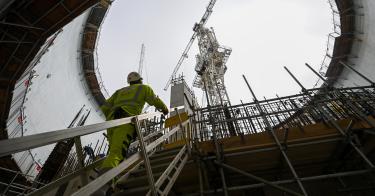Is the Nuclear Renaissance real this time around?
Of course, that question is impossible to answer, but reports from the United Kingdom at least show that there is an opportunity.
The Times in the U.K. just reported that Rolls-Royce is in early talks with the global industrial firm Ineos to provide industrial power for a Scottish oil refinery.
These sorts of uses are exactly what makes nuclear energy so attractive. That’s because refineries need constant power and unlike most renewable sources, nuclear produces that power 24 hours a day and seven days a week. Even the U.S. Department of Energy acknowledges that nuclear power is by far the most reliable energy source we have.
Last year Rolls-Royce announced that it had established a new Small Modular Reactor business and that it raised nearly $235 million in investments toward developing its new 440-megawatt reactor designs. The consortium led by Rolls-Royce secured a further $250 million from the publicly-funded United Kingdom Research and Innovation.
Putting aside the efficacy or legitimacy of public expenditures for private business, the nearly half a billion dollars does show significant private and public support for new nuclear power in Britain.
Given the excessive regulatory and policy risks posed over the years, one can hardly blame private investors for wanting the government to put some skin in the game before risking their own capital.
Nonetheless, investing in nuclear makes a lot of sense.
Nuclear is a unique and underutilized power source. Not only does it safely and securely produce clean, emissions-free electricity, but it’s among the most versatile energy sources we have and can be used for a myriad of industrial applications.
Nuclear could have significant economic benefits as well. Rolls Royce believes that its new reactor business could create up to 40,000 jobs and it anticipates that exports could exceed $300 billion.
Some might argue that we’ve been down this road before.
It wasn’t that long ago that similar headlines were popping up claiming that the world was on the brink of a nuclear renaissance. Like Rolls-Royce, companies around the world were issuing press releases about new investments and establishing new corporate partnerships to take advantage of emerging opportunities in nuclear power.
But then it all fizzled.
While the ultimate outcome of this apparent renaissance remains to be seen, some notable facts distinguish this trend from the aborted efforts of the recent past.
First, unlike last time when the push for new nuclear was built around large, expensive reactors, this effort seems largely to be driven by smaller and potentially less costly technologies.
Though the Rolls-Royce reactor is not technically a small, modular reactor as generally understood, it is about half the size of most reactors operating around the world today.
Other designs being offered, like NuScale’s SMR, are much smaller and can be linked together as power demand rises over time.
Second, Russia’s invasion of Ukraine has brought greater appreciation for the reliability that nuclear power brings.
Though nuclear fuel is sourced from around the world, uranium is plentiful and reactors only need to be refueled every 18-24 months. While uranium fuel is not cheap, per se, the relatively small amounts necessary to fuel a reactor means that you need way less of it and can keep larger amounts of it relatively handy should there ever be a supply disruption.
Lastly, the world is finally waking up to the fatal flaws of an overreliance on renewables. Renewable energy sources may have good applications, but those should be identified by market demand and not foisted onto our power generation systems by political dictate.
Doing so creates systemic instability and results in the power shortages currently being suffered in Europe and to a lesser extent in the United States.
So, this nuclear renaissance must be for real, right?
Not necessarily.
While much is different, much remains the same—at least in the United States.
American nuclear power faces a significant regulatory burden, government remains a major obstacle to fixing our system for nuclear waste management, and meddling politicians and bureaucrats continue to have too much influence over the business of nuclear energy.
With reform, this Nuclear Renaissance has a fighting chance.
Without reform—good luck.
This piece originally appeared in The Daily Signal




